|
As
time marches on, names like Jim Vornholt, Bud Tenney, Bill Werwage,
and Lew McFarland are, unfortunately, fading into the ether of yesterday's
memories. They were the pioneers of control line stunt flying. Unlike
modern day radio control extreme 3-D and precision aerobatics models,
the overall planform of control line aerobatic models has not changed
all that much. Proportion changes are hardly noticeable to
the untrained eye. Engines are now built better and structural components
like carbon fiber are now used, but the most important element of
winning control line contests was and still is pilot skill, which
has gotten better over time like most other forms or sports.
See part two of the
American Control Line Championships. American Control Line
Championships (part 1)
Words & Pix by William Nezeband
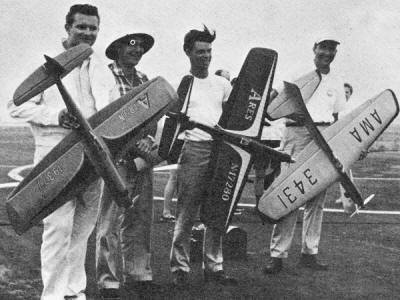
The "Big Three" of stunt, plus one director (from far left):
Jim Vornholt, Bud Tenney, Bill Werwage, and Lew McFarland.
Asks Will Bill (author, wit, amusing dining companion),
"Notice any similarity between the Airon and the Ares?"
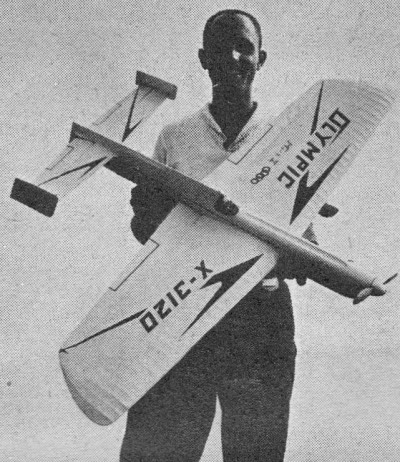
Bob Gialdini, Milwaukee, Wisc., and according to Netzeband
"the best flying ship." Fifth in a line of carefully built
and adjusted stunt craft
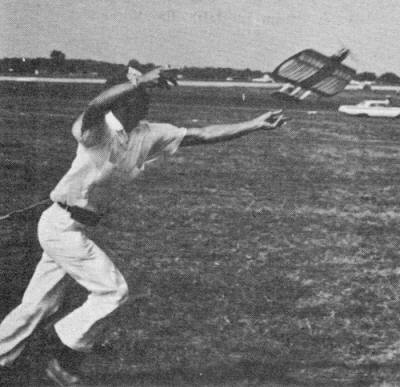
Bill Carpenter's combat plane gets off for its fateful flight
with Cooper. Bill's new model was his "Super Swoop." It
featured more control action for the bigger, heavier combat
powerplants.
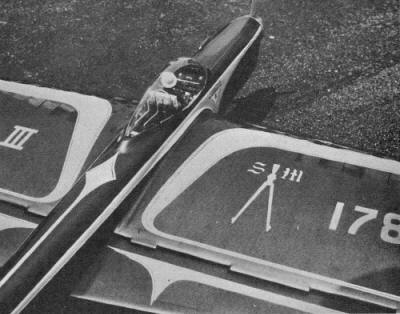
Closeup of the most photographed model at the Nats ...Charles
Lickliter's "Ballerina III." Observe the high finish and
the attention to artistic detail. |
After reviewing three of these affairs, you'd think it would get
easier to pick a theme and take off. Doesn't seem to work, tho.
Each Nats establishes its own tempo and image and there's not a
thing you can do about it. Some are cheerful, some are progressive
and far-reaching, some are eh! You look for outstanding models,
new designs, something different or earth shaking. Sometimes it's
there, more often it's not. The flyers establish part of the theme,
the officials, part, the weather and Naval Air Station the rest
of it. This one felt a little less than cheerful. The usual grumbling
and griping which occurs inevitably at a contest had a strong undertone
of seriousness, and waxed louder than in years past. Without concrete
facts it would be difficult to say exactly why this should be.
It rained on Monday when the judges were being trained and all
of those last minute details of field marking and equipment set
up, were being made. Also most contestants try to iron out the kinks
during the early days, those from riding many miles, those from
a few days layoff and those derived from having a well trimmed model
bounced cross-country in a box or back seat. Having to run through
the rain doesn't improve one's spirits. Monday is always
a good day from the prospect of meeting old and new friends and
catching up on the year that just disappeared in a flash. This year
also brings some nostalgia since our first Nats report was about
the '57 event at Willow Grove. Was going to be interesting to see
how 4 years changed things. We arrived Sunday eve after driving
up with Leonard McCoy, a Radio Control man from Lamar, Mo. He owns
a hot Ford Convertible and we made real good time. It's still 1300
miles tho, anyway you hack it. Almost got indoctrinated into the
R/C fold. Must admit that these Cadillac class fellows are doing
a lot of excellent flying. They certainly had a crowd of flyers
in radio this time with multi-ships (some 160) all over the place.
But we digress. It didn't seem right without George Aldrich,
but he was tied up with something this time. In wandering around
the contestants work hangar we found the smoking lamp out, as it
will be in Glenview and Los Alamitos, because they store fuel under
the hangar floor. Engine running had been limited and moved away
from the hangar. This removes a characteristic sound from the picture,
but really it's good to have some peace and quiet. About 2/3 of
the floor space was devoted to work tables which were full early
Monday. Seems that the Navy had to scurry about and cut the ribbon
early Sunday to let the eager modelers in. Miss America was there
adding her glamour to the scene, if you like that sort of thing.
Who doesn't? Hi Johnson observed pushing new combat rules.
These he will describe at the drop of a hint. I've covered them
in the Capers Column and they bear looking into and trying. More
about this later. Located John Brodbeck over in the other hangar
along with the AYSC boys. The AYSC group are carefully isolated,
models in a guarded room and flight operations up at the end of
the field. Their program this year involved their flying all four
Air Youth categories at the Nats and picking their winner. Forty-two
lads including the Hawaii champ were there. It would have been full
time covering them, so their story must come from elsewhere (Cal
Smith). Meanwhile, back at the work hangar things are buzzing.
People are settling down to the business of preparing old and new
models for the job of flying in this, our biggest show of the year.
The quality of equipment is good, with more well finished stunt
ships than ever. Some scale models are around, but they disappear
rapidly since judging is down at the main hangar under wraps. People
still carry racks of combat jobs, boxes of speed ships and there
are big carriers all over. Seems that the East coast is carrier
territory. See some FAI Team Racers, B team jobs and quite
a batch of Rat Racers when you consider there's no event at the
Nats for them. Watching them fly in the evening it looks like there's
a trend away from pressure and attention to fast pit stops. Jack
Garcia, California, has a slick ship which has turned in such phenomenal
times as 6:21 for the 10 mile. This is done with a Johnson, no pressure,
and an inspired pit man, who can, when hot, restart within 3 seconds.
This is from the time he fields the model, fills it, and cranks
it up. Feeling is high among these people about a Nationals event
for Rat Racing. For their info, we have been carrying discussions
of TR vs RR in our column. Let us present your thoughts. Only through
doing something, can you get what you want. Unfortunately, grumbling
to yourself or your buddies doesn't accomplish much. The
Nats always brings out the people who like off-beat, non-contest
equipment such as Dale Means from Shrewsbury, Mass., and his son
Dale, Jr. They were flying a twin engine ship resembling the old
Brumann "Skyrocket" with a pair of old KB 29's and having a ball
stunting. Were a couple of Jet stunt ships, one of which flew pretty
well, several of the Sabre-Dance models like the one by Dave Holland
with coordinated thrust to weight allowing the ship to prop-bang.
Strictly unusual was one by John Clemens. John claims to be
one of the physically smallest Texans in existence, also maintaining
that he couldn't say where he lived until Alaska joined the Union.
He may be short (aren't we all, at times) but I have yet to hear
anyone top him. Typical conversation between Hi Johnson and John
on the ramp ... Hi, "Hey, John, you're traveling kind of slow".
John, "Yeah, I'm using both feet". Anyhow, John was carrying a minute
model, a 1/2 pint of fuel, a battery and wearing a helmet with an
unusual wire ring on it. Questioning (not much) convinced him to
fly his TD .010 powered bee around his head. After a few laps he
was holding his head on with his hands. Says the ship is ideal for
chasing flies, etc. He proposes an event in which everyone brings
easy chairs, flies models around their heads, and everyone gets
a trophy. When do we start? John, in his spare time handles Nats
publicity and the PA system at the demonstrations.
So,
on with the business of contesting. The stunt judges were trained
by Larry Scarinzi and appeared ready to go Tuesday morn. Monday
nite it was discovered that the old 1957 system of one flight on
each circle was going to be used in the qualifying rounds. Some
fast action put a stop to this nonsense. Bud Tenney had charge of
the proceedings and was in constant attendance at the circles handling
things very ably and amiably. Bud's two specialties seem widely
diverse, Indoor and Stunt, but he enjoys an interesting variety.
Main pressure in running an Aerobatic show is the question of
whether the judges will remain consistent thru a day's flying. Hi
or low isn't important, just so they remain in their particular
area. We have been flying the same pattern for 5 years and the differences
between top men are getting smaller. The Navy men this year held
steady very well. Watching practice flights early in the week one
wondered where the big boys were, since everyone looked rough. Actually
after all the kinks were out they still looked a bit rough, just
a hair's breadth off top trim. Could have been the fact that winds
over and around the hangar caused turbulence and the consequent
roughness. Maybe everyone just had more nerves than usual.
The Juniors led off on Tuesday. The surprise here was the extremely
high finishes turned out. You had to look them over carefully to
find any cracks or nicks. Was personally pleased to see Gerry Cipra
with his beautiful Nobler. Gerry was the youngster I had to disqualify
in the '58 Nats at Chicago. They said then, he'd get building his
own ships and he certainly did. His father, Emil, also had a highly
finished Nobler, but while Gerry came out 2nd in Jr., Dad was elsewhere
in Open. He almost qualified tho. I suspect emphasis was placed
on Gerry's practice. Notice Gerry won beauty in AYSC and placed
4th in AYSC Stunt. Jim Vornholt, flying a real slick airplane
this time, the Airon, was the only one of last year's age class
champs to repeat. The kids fly a lot of stunt and some have enough
polish to compete in Open any time. In the finals, Terry Evans,
St. Louis, threw a part of a prop blade during his first flight.
Rather than deck the ship he elected to fly out the agonizing minutes.
The damage to the ship was amazing, with numerous cracks along the
fuselage and joints. He had a full repair job on his hands.
On qualifying day you look over everyone, like Steve Bittner
from Baltimore. He is flying an Imperial which he's redesigned to
suit himself. Dad helps and as Steve adds to his 13 years he'll
be a good stunt man. Only started last fall. In Senior, most
all the old hands were there: Bill Werwage, Audie Meyers, Jeep Newman,
Ronald O'Toole. Jeep had a rough time after plowing concrete with
his ship after qualifying. He rebuilt it and came in fourth, only
6 points off the top money. He had a whole nose to glass on, which
isn't an easy job. O'Toole was flying one of his own this year,
"Aeolis", along the lines of the ARES and models of that ilk. Wonder
when the boys will run out of Greek Gods. Gary Zeller totaled
his newest Tucker Special in practice and ended flying an older
one. One of this series of ship will be presented later as a construction
article in AM. They had removed some of the weight from last year's
models, helping flying nicely. Werwage's 400 pts put Meyer's 397
into second place. As usual, the top 5 scores in each class are
close enough that anyone could be on top. In the Open class
tension was rampant as all of the top men flew and then sweat out
each other's scores. It was seesaw all day. Lew McFarland almost
lost his ship Monday to the ramp sweeper when it started eating
his lines. His first flight on Friday came out short both the horizontal
and square eights putting pressure squarely on his second flight.
He came thru and went on to pick up the Jim Walker Trophy on Sunday.
Jim Silhavy tried out his new Nobler, but elected to fly last year's
winner. He racked it in Friday morning after qualifying. Seems the
pushrod let go and really broke up the ship. So it goes with tough
luck. Charlie Lickliter attracted a crowd every time he set his
ship down. Truly a beautiful model, the Ballerina III, covered with
Jap Tissue and sporting a flawless paint and decorating job. For
this reporter's money, it could fly better, but he placed second,
so-. Fred Nolls had a big ship powered by a McCoy 35. It ran like
a top and pulled very nicely. It can be done. Taking nothing
from Lew's Shark 45, Bob Gialdini's "Olympic III" is the best flying,
average size stunt ship in the country (or city). Starting in 1957
with a Nobler and carefully evolving thru several models he has
developed a clean, slick turning machine. When he does squares,
they are evenly and exactly timed. The ship turns like it was on
rails and the smoothness is outstanding, almost effortless. He has
moved the gear to the wing, and landings are such that wheel contact
is unnoticeable. The peculiar thing is ... such perfect maneuvers
aren't getting him into the top spot. He was third this time. Perhaps
perfection is not the thing to shoot for. And in 4th place
is Rolland McDonald. This caused me to check up. Rolland flies very
well, and in looking over his past record at the Nats I found that
he has consistently placed around 4th, when he's not tied with Booz.
This indicates a better average than the guys who are up and down,
just like bowling. Of course, when you have your sights set on first,
fourth isn't much consolation. After the flying was over
some of the stunt gang invited Bud Tenney and me to chow with them.
After placing Lew McFarland, Bud, Charlie Lickliter and yours truly
at the head table, they autographed and presented some 14x6 props
"In Appreciation." I don't know what mine was for, but it's hung
in a place of honor. This Stunt gang is the nicest group of nervous
wrecks I've ever known. Le Combat this year was a repeat
of Dallas, maybe more so. Fellows, these rules have got to go! I
carefully watched a lot of action, and then checked my thoughts
with the judges. Such a diversity. Invariably, decisions are based
on who hit whom, or some far-out reaching for obscure rulings. The
rules coupled with the frantic antics of models and pilots force
the judges into a corner most of the time. Action usually consists
of a line yank-off of one whole streamer, a collision or a single
prang and an argument. A good match between hot pilots usually
ends abruptly and indecisively. Bentley Page got a line cut and
played it cool thinking he'd scored. He was ruled the loser for
lack of aggression. Ted Cooper and Bill Carpenter collided destroying
Bill's "Super Swoop." Cooper was ruled winner as being hit. Oesterle
and Chrisman put on a superb, no-score for several minutes before
they piled up, in a Senior match. This is about all the details
I'm going to give on matches, since they never came out like I saw
them. Randy Tucker, last year's Senior champ, accosted me
and asked why I lie in my reports. Mistakes maybe, but lies don't
help a thing. Seems that I said Brown cut too close and got Randy's
collision zone. Randy says he passed over too quickly and cut his
own safety string. They were head-on to me when it happened so I
apologized to him. Seems he was getting static at home for some
reason. The kicker comes from Dick Brown's thoughts on that fatal
maneuver. He says he (Dick) actually did cut in too close, but was
coming down while I thought he was going up. Also was gently informed
by Pete Peters that Wooten didn't have any cuts in the Carpenter
match last year.
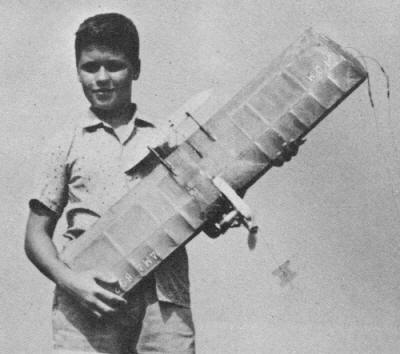
Tom Teeter, New Kensington, Pa., 2nd in Jr Combat. Stabilizer
type model; Johnson power. Sez WN: "Watch this boy, he's
good!"
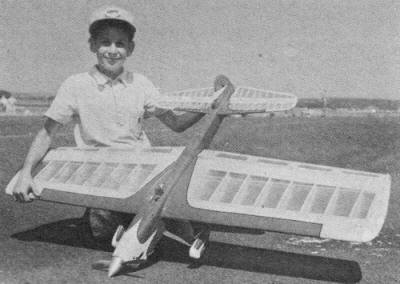
Steve Bittner, Baltimore, Md., is just beginning contesting
with reworked Ringmaster Imperial. Coming along fine.
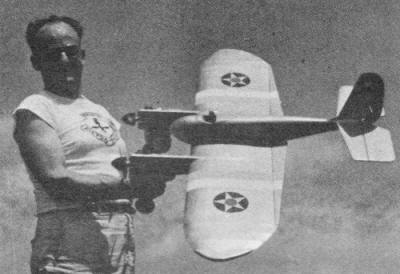
Strictly-for-fun plane is this twin engine deal (above)
by Dale Means, Shrewsbury, Mass. Real good idea opines author. |
So I herewith refrain from any more match commentary.Starting
out model wise there were many versions of the Twister, VooDoo,
Equalizer design. The Mexican crew landed with about 3 Twister variations
each. We could learn from them, since their equipment is immaculate,
certainly too well-built for our Combat. They really have the teamwork
and spirit, such that when they fly it's like a well-oiled machine
complete with razzle-dazzle rooting sections. Pablo Samperio came
out third for them after several weird and bruising matches along
the line. After the three qualifying days realized that there
were at least 187 different designs being used. No trend, except
to stabilator jobs, but all of the winners were lackluster types
of conventional layout. The last match in Junior between Frank Pisz
and Tom Teeter was an outstanding example of sportsmanship.
Frank was up first and when Tom got up his engine was very sick.
Frank held off until Tom's engine came in and then he proceeded
to eat him up cleanly and quickly. Randy Tucker made it to the finals,
but got killed by Schmitt in the first round. Henry Schell beat
out Don Sopka in Senior. The open last match was too weird to try
to report accurately, but Jim Ribar won over Ted Cooper.
Were it not for Doy Black and Pete Peters' judging combat each year,
we'd be a lot worse off. These two are walking rule machines and
the best qualified combat judges in the country. You have to be,
to retain any semblance of accuracy. Too many of the matches required
some obscure decision and a goodly number were vague enough to require
re-matching. These rules involving scored string cuts and time-in-the-air
points would eliminate guesswork for the judges and would make combat
more pleasant all around. Maybe the flyers like to argue, but judges
are at it all day and don't care to argue about every cotton-pickin'
decision. Each additional improvement (?) over the years has complicated
things beyond hope. A thorough cleaning is necessary. It must be
started now, in order to be effective. The Johnson engines
dominated numerically, with the newer Foxes coming along. Handling
these hot power plants still bugs a lot of flyers, but they've got
the soup. Have found that it is hard for a lot of people to tell
by ear when the engine is peaked perfectly and too many times they
are peaked out on the ground. The superior breathing then causes
them to lean out in the air and burn. The new KB engines weren't
ready in time for the Nats, but tests indicate they'll be around
in force next year. Next month the insides of Speed, Carrier,
Team Racing and some Scale. Tune in? -
Posted May 4, 2013
|